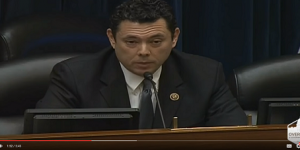Thanks to Barack Obama’s massive increase in immigration both legal and illegal, the job prospects for average Americans has nosedived and real wages have stalled making middle-class Americans poorer.
In 2013, it [Obama’s immigration policies] flooded the weak job market with an astounding tsunami of three million additional new workers.
That’s a shocking 85 percent increase in the new labor supply. That’s six imported workers competing side-by-side with every seven children of the 1968 Americans. That’s almost one foreign worker for each one child of the ’68 generation.
Of course, Americans’ participation in the workforce dipped, wages flatlined and company profits peaked. Of course, the Dow Jones stock-market index boomed by 26 percent, delivering almost $5 trillion in gains to America’s richest families.
Looking at the numbers, its easy to see why the job participation rate is at a multi-decade low while real wages for middle-class Americans has been stagnant for years.
By the end of 2013, the number of native-born Americans aged 16 to 65 with jobs had nudged up by only 700,000, to 113.5 million. In fact, fewer-working-age Americans had jobs at the end of 2013 than had jobs in 2000.
In contrast, the number of foreign-born people in the workforce rose from 17.1 million in 2000, up to 22.4 million at the end of 2013. That’s a gain of 5.3 million, amid a loss of 1.3 million Americans’ jobs.
That shift away from Americans meant that foreign-born people held one-in-six jobs at the end of 2013, compared to one-in-eight jobs in 2000.
Amid Obama’s flood of new foreign labor, median weekly wages for full-time workers were flat all year, at $334 in constant 1982-84 dollars. Inflation-adjusted weekly wages earned by African-Americans dropped by a dollar to $270, while Latinos saw their wages rise by a dollar to $248.
Most of the complaining done by Obama and the Left about the so-called “gap” between the super rich and the rest of America can be traced to immigration policy.
Obama’s extra supply of labor in 2013 even coincided with a flattening of mid-recession productivity growth, perhaps because companies were able to hire more low-risk disposable labor rather than invest in productivity-boosting machinery. Obama’s aidestried to deny any connection, but the cheap-labor explanation for flat productivity is compatible with long-term records, which show that U.S. productivity gains slowed after 1965 once extra foreign workers reduced marketplace pressure for high-tech investment, following 40 years of low immigration and high productivity growth.
In contrast, Japan has adopted a different economic strategy, which supplements its shrinking domestic labor supply with robots rather than culturally discordant foreign workers.
There are many policy choices the President could have made to lessen the impact of this uncontrolled flood of low-skill immigrants from swamping the job market for Americans.
If 2013 is considered the starting point for immigration, then 4.4 million Americans — the 3.5 million children of 68′ babies, plus all the 900,000 children of subsequent immigrants — turned 18 in 2013. That class of 4.4 million Americans was hit by Obama’s 2013 wave of 2.1 million new foreign workers. In effect, Obama delivered two foreign workers for every four young native-born or immigrant Americans who turned 18.
That two-for-four measure is the most charitable calculation of Obama’s 2013 migration shock against Americans.
But a less-charitable calculation looks at what Obama could have done to reduce the labor shock.
A back-of-the-envelope calculation shows he could have easily shifted the impact from two-for-four to perhaps one-for-nine.
For example, in 2013, he could have slowed Green Card approvals and tightened border security. If that policy reversal had delayed and reduced the new arrivals by only 50 percent, he would have reduced the new foreign workers in 2013 by 350,000 in one year.
He could have reversed his choice to award or renew work-permits issued to illegals, refugees and other inflowing groups. That would have opened up to 1.5 million jobs for Americans in 2013.
If Obama had wanted, he could have told his deputies to use agency funds to pay migrants to go home (as Israel does), and to prosecute employers who provide illegals with jobs. Obama also could have ordered his deputies to deport all migrants convicted of law-breaking.
But those reversals didn’t happen. In 2013, Obama’s immigration agencies “encountered more than 700,000 aliens who could have been removed… Most were found in jails. But they took action against fewer than 200,000,” according to the Center for Immigration Studies. During the last year of President George W. Bush’s tenure, Bush’s managers allowed agents to repatriate only 171,540 migrants arrested far inland from the border. Under Obama, the number fell to 110,781 in 2013. If actual enforcement of immigration policies had solved only five percent of the illegal migrant problem in 2013, Obama would have created another 550,000 open jobs for Americans
The president could have reversed his current campaign to ease and increase the annual flow of guest-workers. He could have raised wage-formulas, shrunk exceptions, increased regulatory oversight, extended background checks, and stigmatized companies that hire guest workers. If that policy reduced the number of guest workers by just over one-third, that would have opened 250,000 new jobs for Americans.
Those steps would have the reduced the flow of foreign labor by up to 2,650,000 in 2013. That would have meant the only 500,000 foreign workers would have arrived to compete for jobs against the 4,400,000 Americans who turned 18 in 2013.
Open Border’s shills claim immigration is a net positive for the United States. However, a look at the data shows:
Immigrants’ average productivity and wages are far below American’s levels, ensuring that they get subsidies from taxpayers. In fact, 51 percent of immigrant-headed householdsadmitted using at least one welfare program in 2012, far above the 30 percent of native-headed households that relied on a welfare program. Legal immigrants aren’t much more productive than illegal migrants — they account for 75 percent of welfare payments made to immigrants.
If migrants were good for Americans, the evidence should be clear in California, which has received the most migrants. But 57 percent of young workers in California are stuck in low-wage jobs, which pay a median wage of $9.04, down roughly 10 percent loss since 2000. According to a federal gauge, the state is now the least-equal in the nation.
In short, unskilled immigrants drag down Americans’ average productivity and wages, especially in low-end jobs, such as cook, trucker and meat processor.
But middle-class and university-trained Americans also have their income reduced by the extra taxes used to support low-skill migrants. Roughly speaking, each household headed by a college-graduate pays enough taxes to fund the welfare and aid given to a household headed by an low-income immigrant.
Oddly, Obama used to understand this connection between low-skill immigrants and depressed wages for Americans.
Obama knows that immigration hurts lower-skilled Americans, especially African-Americans. “The number of immigrants added to the labor force every year is of a magnitude not seen in this country for over a century,” Obama wrote in “The Audacity of Hope,” his 2006 autobiography. “If this huge influx of mostly low-skill workers provides some benefits to the economy as a whole… it also threatens to depress further the wages of blue-collar Americans and put strains on an already overburdened safety net,” he acknowledged.




























